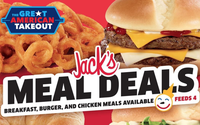
Keeping up with the
post-pandemic fast-food customer may be even harder than many restaurants think, with consumer concerns and preferences still evolving.
Take family meal bundles -- generally an entree,
side and beverage packaged together -- a solution many lauded when they were first launched early on in the crisis. Families, exhausted from working, parenting and homeschooling while sheltering
in their living rooms, initially loved the idea of picking up family meal bundles at their local drive-through.
Now, not so much. New research from MarketForce Information, an
experience-management company, finds that while 24% of QSR diners say they found family meals very attractive at the beginning of April, that fell to 16% in May. Among casual dining customers, the
sentiment fell from 31% to 25%.
advertisement
advertisement
The report, based on 4,000 customers, says consumers are finding the bundles expensive, and think they lack variety in both menu items and meal sizes.
This week, many cities and restaurants are betting big on alfresco dining, another creative possibility, to help recoup lost sales and tax revenues. I hope so. But in cities trying to adopt such
plans, there are obstacles, like traffic, parking -- and the reality that in much of America, eating outdoors in the summer is no fun.
Every restaurant is eager to come up with the right
balance for their markets and customers -- without knowing exactly what that will be.
It’s worth keeping a close eye on China, offering clues to the rest of the world on what virus-wary
consumers are craving.
A recent report from CapGemini, a consulting company, says that the QSR category in China is benefiting from an intense focus on hygiene, as well as stepped-up digital
transformation. Even without customers, restaurants required staff to wear masks, sanitize hands, and have body temperature checked frequently. Restaurants also monitored delivery-service staffers'
body temperature and had them wash hands before and after deliveries.
Chinese QSRs also built external pick-up counters so delivery operators didn’t enter the restaurant. And most
deliveries were accomplished using outdoor racks at apartment buildings. But they also stepped up digital offerings, such as mini-apps that made it easier to order at nonpeak times.
Now, even
with the lockdown over, consumers still feel safer with takeaway. At KFC, for instance, delivery sales as a percentage of company sales approximately doubled during this period. And at Starbucks,
where traffic has slowly been shifting back to in-store dining, online orders represented 27% of the total by the end of March, compared to an average of 10% a year ago.
In other words,
creativity and agility -- like adapting meal kits and setting up outdoor seating -- are important. But the key ingredient continues to be keeping workers and customers safer -- and making sure
everyone knows those precautions are in place.